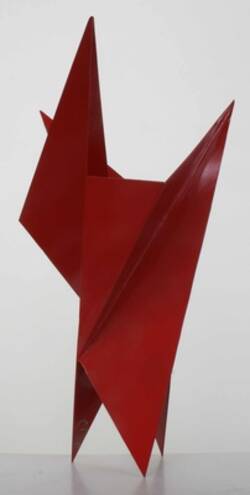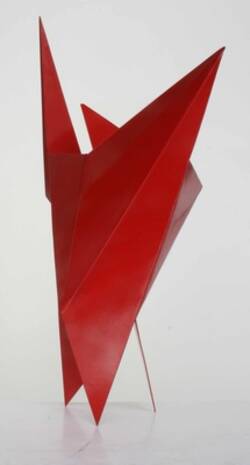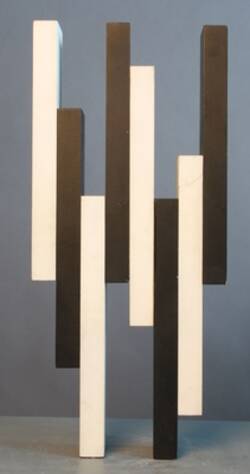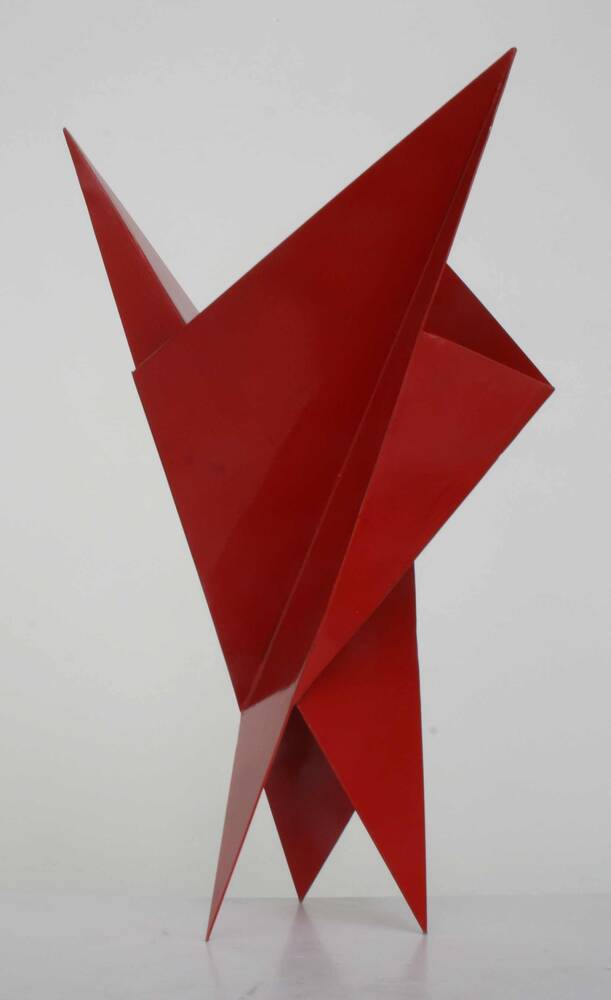Hermann Glöckner: Lower Folding Zone of the Mast, 1975
Dresden artist Hermann Glöckner studied technical drawing at vocational school. Even in those days, he was fascinated by the beauty of geometric forms, sensing something in the lines and surfaces going beyond sheer geometry. When he began working as a pattern designer, he quickly found he had other aspirations and dreamt of working freely as an artist. After several unsuccessful applications to the Academy of Fine Arts in Dresden, Glöckner became largely self-taught. Until his death in 1987 aged 98, his creative output was informed by his abstract sculptural ideas. This small sculpture not only embodies the major design principle in his entire oeuvre – the art of folding – but also stands for the late appreciation of his work in the GDR.
For many years, Hermann Glöckner made his works in isolation. In the GDR, abstraction was long regarded as reactionary and individualist. In 1975, when Hermann Glöckner was 86 years old, he finally received a commission for a large outdoor sculpture. His 15-meter-high Folding Zone with Two Masts in front of the refectory at Dresden University of Technology is ranked as the first monumental Constructivist sculpture in public space in the GDR. Glöckner also produced this Lower Folding Zone of the Mast in a small format, painting it bright red. It is, without doubt, an independent work.
Incidentally, Glöckner’s ‘folding’ technique first appeared in his Tafelwerk, an experimental series from the late 1920s dividing surfaces into geometric forms. When he then began gluing on folded strips of silk paper, he took the first step towards three-dimensional works.
His sculptures follow the rules of geometry, precisely calculated and meticulously created. The Lower Folding Zone of the Mast is so intricately folded, it is almost impossible to imagine the source material it started from.
Further Media
Women artists in the collection / in the GDR
As a museum for art across the genres, the Albertinum’s collections offer a vast array of works from around 1800 to today, from the groundbreaking paintings by an artist such as Caspar David Friedrich to amazing glass works by Gerhard Richter. Yet despite the wealth of art in the collection, the Albertinum’s Director Hilke Wagner still sees areas for improvement:
“Of course, we have a lot of women’s portraits in our collection, but what we are painfully missing are works by women artists – and that applies far back into the nineteenth century. Around five per cent of our holdings are by women artists in the years from 1800 to the twenty-first century. So naturally one of our key tasks over the next years is to retrospectively correct the canons which have constantly overlooked the work of women artists.
Hilke Wagner, who was born in Kassel, was especially surprised to find the holdings of art from the GDR also had very few works by women artists.
“Of course, I always had this idea in my mind of absolute gender equality in the GDR. In reality, as I discovered in conversations with women artists, it was no better than in West Germany. In the art world, I think, there was very little difference between East and West Germany.”
So Hilke Wagner regards it as even more important to close the gaps in the collection and retrospectively acquire art by women artists in the GDR. Here, a comparison with works by male artists would be very promising:
“Overall in the GDR, art had a strong tendency to return to mythological figures. I find it telling here that male artists often chose unsuccessful mythological figures – the losers, as it were, such as Sisyphus or Icarus. In contrast, women artists in the GDR frequently portrayed the courageous, crazy female revolutionaries, for instance, Cassandra, Medea, or the Amazon queen Penthesilea. I think that stands out quite prominently, as does the way the GDR’s women artists are particularly conspicuous for their greater resilience.”
- Location & Dating
- 1975
- Material & Technique
- Metal, painted red
- Dimenions
- H: 35,4 cm, B: 20,4 cm, T: 18,5 cm Gewicht: 0,8 kg
- Museum
- Skulpturensammlung
- Inventory number
- ZV 4149



